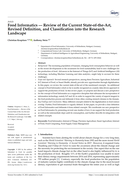New publication in MDPI Foods [15.11.21]
Christian Krupitzer from the Department of Food Informatics is author of the publication "Food Informatics - Review of the Current State-of-the-Art, Revised Definition, and Classification into the Research Landscape" in MDPI Foods (Impact Factor: 4.350).The publication "Food Informatics - Review of the Current State-of-the-Art, Revised Definition, and Classification into the Research Landscape" by Christian Krupitzer (Department of Food Informatics, University of Hohenheim) with co-author Anthony Stein (Department of Artificial Intelligence in Agricultural Engineering, University of Hohenheim) was published in MDPI Foods (Impact Factor:4.350).
The increasing population of humans, changing food consumption behavior as well as the recent developments in the awareness for food sustainability lead to new challenges for the production of food. Advances in the Internet of Things (IoT) and Artificial Intelligence (AI) technology, including Machine Learning and data analytics, might help to account for these challenges. Several research perspectives, among them Precision Agriculture, Industrial IoT, Internet of Food, or Smart Health, already provide new opportunities through digitalization. In this paper, we review the current state-of-the-art of the mentioned concepts. An additional concept is Food Informatics which so far is mostly recognized as a mainly data-driven approach to support the production of food. In this review paper, we propose and discuss a new perspective for the concept of Food Informatics as a supportive discipline that subsumes the incorporation of information technology, mainly IoT and AI, in order to support the variety of aspects tangent to the food production process and delineate it from other, existing research streams in the domain. Many different concepts related to the digitalization in food science overlap. Further, Food Informatics is vaguely defined. In this paper, we provide a clear definition of Food Informatics and delineate it from related concepts. We corroborate our new perspective on Food Informatics by presenting several case studies of how it can support the food production as well as the intermediate steps until its consumption, and further describe its integration with related concepts.
The publication is available in MDPI Foods.


